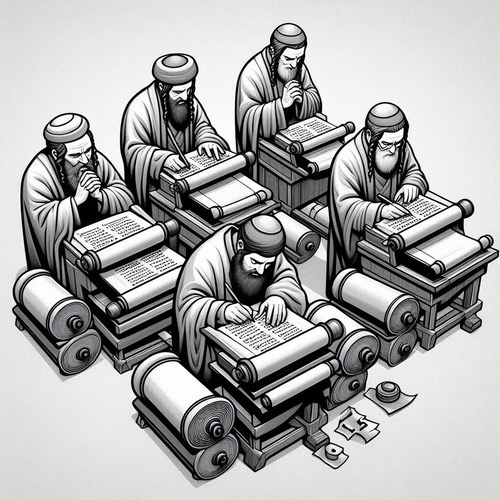Satan’s Lie: You Can’t Trust the Bible—It’s Been Changed Over Time
Part of our series: “Satan’s Lies: Common Deceptions in the Church Today”
Satan’s Lie: You Can’t Trust the Bible—Scepticism about the Bible’s reliability runs rampant in our churches today. One of Satan’s most persistent lies is that Scripture has been corrupted over time. The lie suggests today’s Bible bears little resemblance to the original texts. But what does the evidence actually tell us about biblical preservation and reliability? Let’s examine the overwhelming historical and scholarly evidence that thoroughly dismantles this falsehood.
SATAN’S LIE: YOU CAN’T TRUST THE BIBLE—MAKING SENSE OF THE CLAIM
Many sceptics argue that after thousands of years of hand-copying, translation, and transmission, today’s Bible must be fundamentally different from its original form. This argument seems logical at first glance—after all, even careful copyists make mistakes, and wouldn’t these errors compound over time? This “telephone game” analogy has become a common objection to biblical reliability.
However, this perspective fundamentally misunderstands how biblical texts were transmitted and preserved throughout history. Unlike the telephone game, we have access to thousands of ancient manuscripts, allowing scholars to compare and verify biblical texts across different time periods and geographical regions.
THE MANUSCRIPT EVIDENCE
When we examine ancient manuscript evidence, the Bible stands unparalleled in its textual preservation. Consider these compelling statistics:
Old Testament Reliability
- The Dead Sea Scrolls, discovered between 1947-1956, contain biblical manuscripts dating back to 250 BC
- These ancient texts show remarkable consistency with medieval manuscripts
- The Isaiah scroll, for instance, shows 95% word-for-word agreement with modern texts
- Variations are primarily spelling differences and minor stylistic changes
New Testament Manuscript Abundance
- Over 5,800 Greek manuscripts of the New Testament
- More than 20,000 manuscripts in other ancient languages
- Earliest fragments date to within decades of original composition
- Compare this to other ancient texts: Homer’s Iliad has 643 manuscripts, Plato’s works have 7 manuscripts, and Julius Caesar’s Gallic Wars has 10.
THE ANCIENT COPYING PROCESS: METICULOUS CARE IN TRANSMISSION
The transmission of biblical texts wasn’t a casual endeavour—it involved sophisticated systems of preservation and verification. The Jewish scribes had a meticulous system of textual preservation ensuring remarkable accuracy in transmitting biblical texts.
- Strict rules governed the copying process: The copying process was governed by strict rules under the Talmudic law. Everything from the type of parchment and ink to the precise spacing between letters and words was specified. Scribes even verbally pronounced each word before writing it, ensuring conscious engagement with the text.
- Each scroll was checked multiple times: Different scribes would independently check the copy against the original, examining everything from letter count to paragraph breaks. Typically, there were at least three separate checks by scholars.
- Specific counting methods verified accuracy: The Masoretes developed sophisticated counting methods to verify accuracy. They would count the number of words and letters in each section, identifying the middle word and letter of each book, and maintain detailed notes about textual features.
- Copies with errors were destroyed: When errors were discovered during the verification process, those copies were immediately destroyed. This practice ensured defective manuscripts weren’t circulated or allowed to corrupt the textual tradition.
- Worn scrolls were ceremonially buried: Out of reverence for Scripture, worn-out scrolls received special treatment. Rather than being discarded, these aged texts were ceremonially buried in special storage areas, often alongside respected rabbis. This practice both preserved the sanctity of God’s word and prevented deteriorating texts from being misused.
Early Christian Copying Methods
The early Christian community developed their own rigorous approach to preserving biblical texts, building on Jewish traditions. Professional scribes, often working in established scriptoriums, followed detailed standards for copying texts. They were typically highly educated specialists who understood multiple languages and had extensive training. Their professional standards included guidelines for page layout, punctuation, and abbreviations.
- Multiple verification steps: The verification process involved multiple steps: one person would read the text aloud while another checked the copy, followed by additional reviews focusing on different aspects like spelling, punctuation, and sense units.
- Corrections noted in margins: When discrepancies or uncertain readings were discovered, scribes carefully noted these in the margins rather than making arbitrary changes. These marginal notes, called apparatus criticus, preserved alternative readings and demonstrated the scribes’ commitment to transparency in transmission.
- Widespread distribution allowed cross-checking: Unlike other ancient documents that were preserved in single locations, Bible manuscripts were spread across different regions. This meant no single error could corrupt the entire textual tradition, as copies from other regions could be cross-referenced to identify and correct variations.
TEXTUAL CRITICISM: STRONG EVIDENCE FOR RELIABILITY
Modern textual criticism actually strengthens our confidence in the Bible’s reliability. Here’s why:
Understanding Variants: When skeptics point to the existence of textual variants as proof the Bible has been corrupted, they fail to understand the true nature and significance of these variations. The vast majority of these variants are incredibly minor, consisting primarily of insignificant spelling differences or rearrangements of word order that do not alter the meaning in the slightest. Even more remarkable is the consistency we find across the earliest Bible manuscripts. Scholars estimate a staggering 99.5% of the text has been transmitted to us intact, with only the most minuscule fraction subject to any meaningful variation.
Comparing Manuscripts: The breadth and diversity of the manuscript tradition further validates the Bible’s reliability. The texts span multiple continents, languages, and time periods—yet demonstrate remarkable consistency. Textual critics can cross-reference manuscripts originating from vastly different geographical regions, cultural contexts, and historical eras. The fact that these texts, written independently by scribes across the ancient world, align so closely in their content is a powerful apologetic for the Bible’s reliability. It demonstrates that the text we possess today has been passed down with remarkable fidelity, not corrupted by the ravages of time.
THEOLOGICAL WEIGHT: THE SIGNIFICANCE OF BIBLE RELIABILITY
Discussions on the Bible’s reliability aren’t merely academic—they have profound implications for our faith and daily walk with God. Understanding the evidence for biblical preservation strengthens our trust in God’s promises and His sovereign care over His Word.
Divine Preservation: A Testament to God’s Faithfulness
The Bible’s unparalleled preservation across millennia testifies powerfully to God’s faithfulness in safeguarding His Word. Despite being written by dozens of authors over 1,500 years, the biblical text has maintained a remarkable integrity and coherence that defies natural explanation. This historical continuity demonstrates God’s superintending hand, protecting His inspired revelation through wars, persecutions, and cultural changes. Moreover, the unified redemptive narrative and consistent doctrinal teaching found from Genesis to Revelation could only arise from a supernaturally preserved text – not one corrupted by human hands over time.
Impact on Faith: Confidence in God’s Living Word
The trustworthiness of Scripture has profound implications for the life of faith. Knowing we can confidently rely on the Bible’s promises and authority transforms how we navigate life’s challenges and make decisions. The reliability of God’s Word provides an unshakable foundation for Christian doctrine and empowers genuine spiritual growth as we engage with His living, preserved message. When we approach the Bible with the assurance that we are reading the very words God intended to communicate, our faith is emboldened, our obedience strengthened, and our lives transformed by the power of the Spirit working through His inerrant Scriptures.
CONCLUSION: DEFEATING SATAN’S LIE
The evidence overwhelmingly demonstrates that today’s Bible faithfully represents the original texts. This isn’t just scholarly opinion—it’s supported by thousands of manuscripts, rigorous transmission practices, archaeological discoveries, and careful textual criticism.
Satan’s lie about biblical corruption fails in the face of historical evidence. The Bible we hold today is not a product of centuries of corruption but rather stands as a testament to God’s faithful preservation of His Word through the ages.
Satan’s Lie: You Can’t Trust the Bible—Related FAQs:
- What historical confirmations exist for the Bible’s accuracy? Archaeological discoveries have repeatedly validated the historical details recorded in Scripture. Excavations have unearthed physical evidence of biblical cities, cultures, and figures, confirming the accuracy of the biblical narrative. For example, the discovery of the Tel Dan Stele in the 1990s provided an ancient extra-biblical inscription referring to the “House of David,” corroborating the existence of this key biblical king. Such archaeological finds lend strong support to the Bible’s reliability as an ancient historical record.
- What are some recent discoveries that affirm the Bible’s accuracy? Even in modern times, new archaeological evidence continues to emerge that affirms the precision of biblical accounts. For instance, in 2016, a clay seal impression was discovered in Jerusalem that bears the name of the biblical prophet Isaiah, providing tangible proof of this important figure. Ongoing excavations around biblical sites also uncover artefacts, inscriptions, and architectural remains that consistently align with the geographical and cultural details described in Scripture. These recent discoveries underscore the historical reliability of God’s Word.
How do Reformed Christians approach the issue of biblical reliability? The Reformed tradition has consistently upheld the doctrine of the Bible’s full inspiration and inerrancy. Figures like John Calvin and the authors of the Westminster Confession of Faith emphasised God’s supernatural preservation of Scripture, arguing that the biblical text we possess today faithfully represents the original autographs. This Reformed perspective rejects the notion of widespread, substantive corruption, instead affirming that the Scripture we have access to is the very Word of God, handed down with precision through the ages. This high view of biblical reliability is a hallmark of historic Reformed theology.
- Why does the reliability of the Bible matter for our faith? The trustworthiness of Scripture is foundational for the Christian life. If we cannot rely on the Bible as God’s inerrant, preserved Word, the very bedrock of our faith becomes unstable. Confidence in biblical reliability allows us to fully trust in God’s promises, submit to scriptural authority, and build our theology on solid theological ground. It assures us that the message we have received is the same revelation entrusted to the biblical authors, empowering genuine spiritual transformation. The reliability of God’s Word is essential for cultivating a vibrant, unshakable faith.
- What does archaeological evidence reveal about the Bible’s accuracy? Archaeological discoveries over the past centuries have provided remarkable confirmation of the Bible’s historical details. Excavations have unearthed physical evidence validating the existence of biblical figures, civilizations, and geographical locations described in Scripture. For example, the discovery of the Siloam Inscription in Jerusalem corroborates the biblical account of King Hezekiah’s construction of a water tunnel. Likewise, artefacts like the Black Obelisk of Shalmaneser III and the Cyrus Cylinder demonstrate the accuracy of the Bible’s portrayal of ancient Near Eastern kings and empires. This overwhelming archaeological evidence strongly affirms the Bible’s reliability as an ancient historical document.
Satan’s Lie: You Can’t Trust the Bible—Our Related Posts:
- Biblical Textual Criticism: Unveiling the Reliability of Scripture
- Dead Sea Scrolls: How Ancient Texts Confirm Bible Integrity
- Divine Fingerprints on Ancient Parchment—The Dead Sea Scrolls
- Archaeology Endorses Scripture: Papyri and Dead Sea Scrolls
Editor's Pick

Why Do People Hate the Doctrine of Election?
…WHEN THEY REALLY SHOULDN’T Few Bible doctrines provoke stronger reactions than election. The idea that God chose some for salvation [...]

The Doctrine of Providence: Does God Really Govern All Things?
You’re sitting in the doctor’s office when the diagnosis lands like a thunderclap. Your mind races: Why this? Why now? [...]

No Decay, No Defeat: What It Means That Christ’s Body Saw No Corruption
On the Day of Pentecost, Peter stood before thousands and made a startling claim: David's body decayed in the tomb, [...]
SUPPORT US:
Feel the Holy Spirit's gentle nudge to partner with us?
Donate Online:
Account Name: TRUTHS TO DIE FOR FOUNDATION
Account Number: 10243565459
Bank IFSC: IDFB0043391
Bank Name: IDFC FIRST BANK






